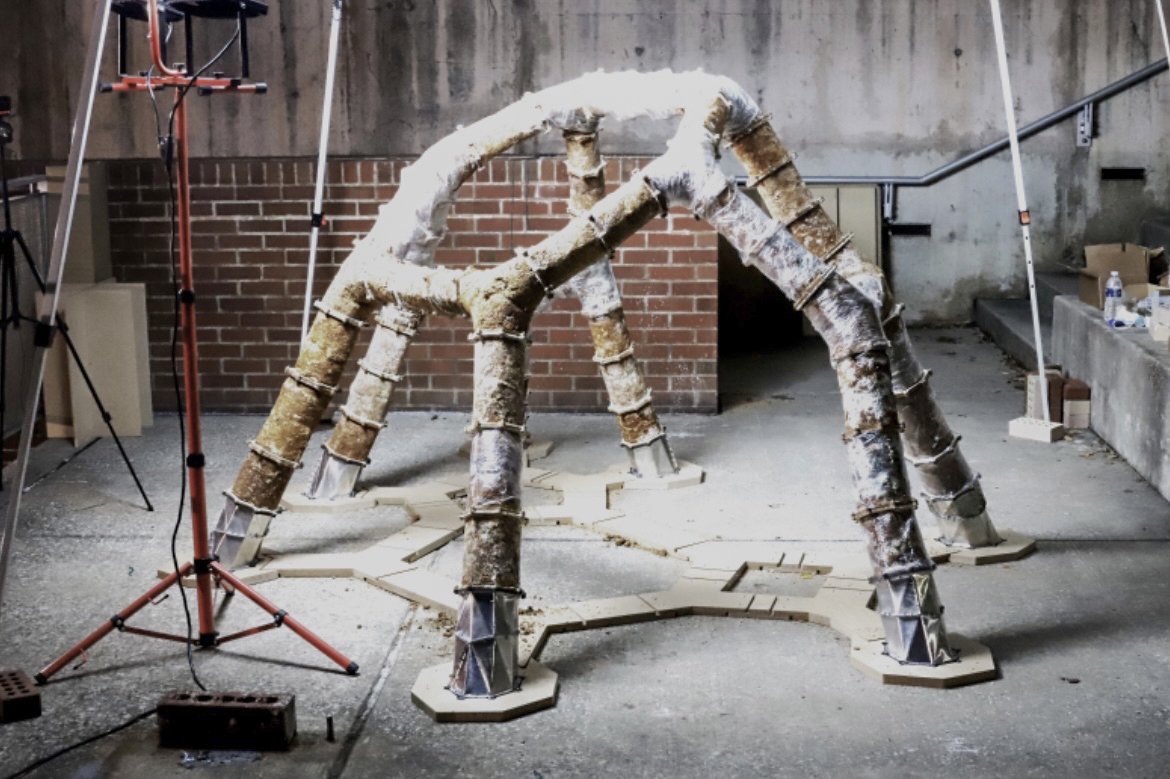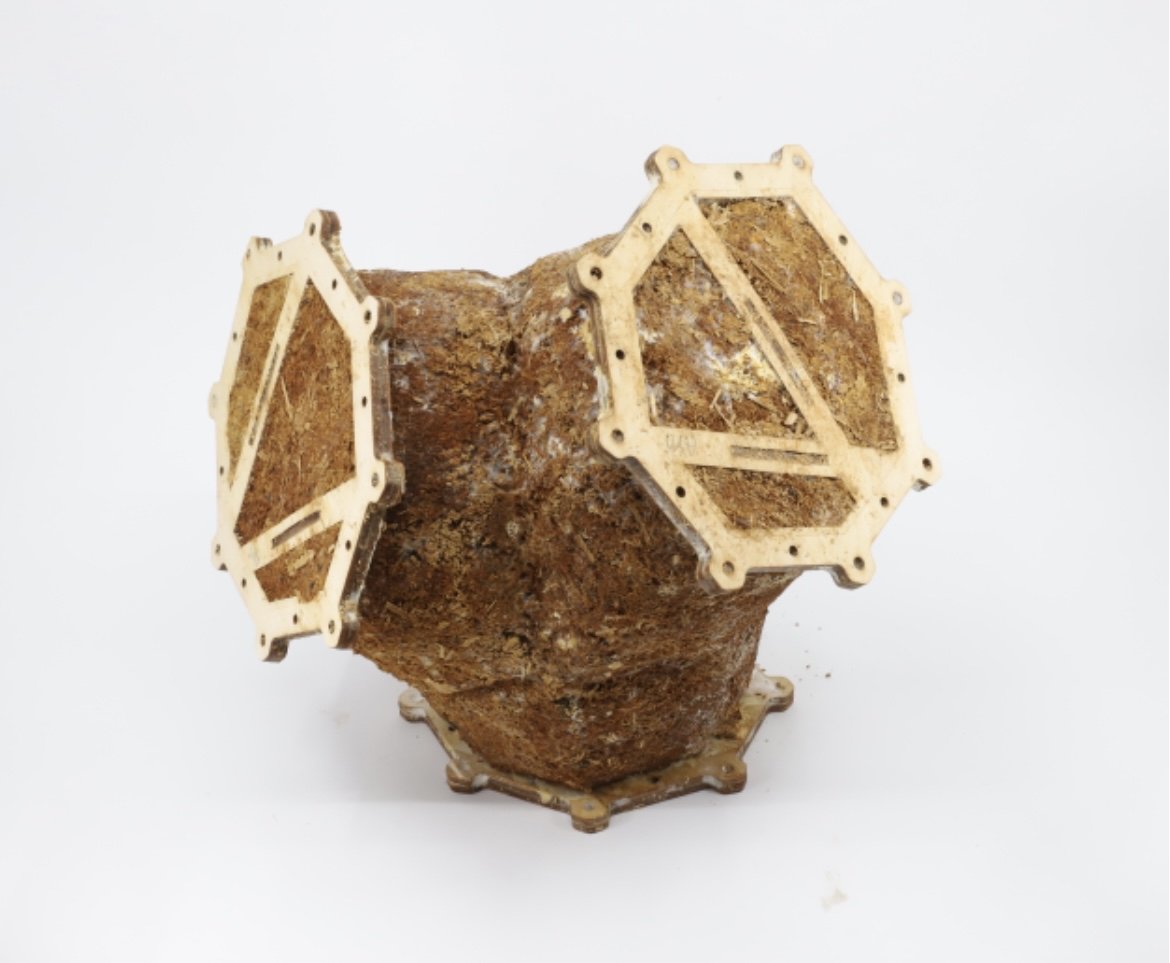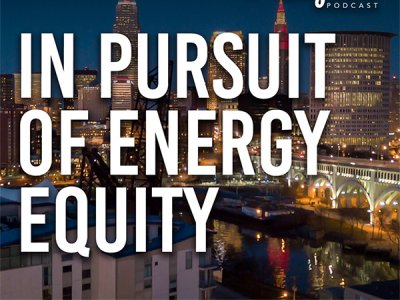According to reports, the building industry is responsible for a lot of the carbon emissions in the world, about 37% in the U.S. This includes the production of materials, construction, operation, and even deconstruction. Additionally, the world will need alternative building materials to keep up with the demand of the construction industry. In this episode of Growing Impact, we explore a seed grant project that looks to use mycelium, the root structure of fungi, as a renewable, biodegradable building material with a small carbon footprint.


Transcript
INTRO: We’re working with biomaterials, and specifically now we're working with mycelium-based materials. Mycelium is the root parts of the fungi. And in the last couple of years, there is ongoing research to explore developing mycelium-based composite materials that are used in architecture and building.
HOST: Welcome to Growing Impact. A podcast by the Institutes of Energy and the Environment at Penn State. Growing Impact explores cutting-edge projects of researchers and scientists who are solving some of the world's most challenging energy and environmental issues. Each project has been funded through an innovative seed grant program that is facilitated through IEE. I'm your host, Kevin Sliman.
Today on Growing Impact, I speak with Benay Gürsoy, an Assistant Professor of Architecture about her project titled “Mycelium-Based Bio-Composites in Architecture: A Biodegradable and Renewable Alternative to Construction.” Her project investigates using the roots of fungi to create biodegradable and sustainable building materials in an effort to reduce the carbon footprint of the building industry, which impacts everything from climate change to landfill waste. Thank you for being on the podcast today, Benay.
Benay Gürsoy (BG): Thank you for the invitation. Building industry, according to reports, has a big share in global carbon emissions -- like in the United States alone, the building sector accounts for about 37 percent of all greenhouse gas emissions. In Europe, this is about 40 percent, and this is likely to continue. This includes building materials, transportation, building operations, industry. And among this share, building materials take a considerable amount of energy to manufacture, ship to the project site, and install. Conventional building materials that we use today -- like concrete, steel, aluminum -- they account for more than 20 percent of all global carbon emissions.
And we know that a significant portion of these materials are produced for the construction industry, especially concrete. The embodied energy of concrete, which is the total energy required for the extraction, processing, manufacture, and delivery of building materials to the project site. That's very high for concrete, because cement production is extremely energy and fossil fuel-intensive. So this means the carbon emission of concrete is very high because the energy consumption produces CO2, and this contributes to global warming. Also, in addition to this, the resources that we use today for these materials are limited. And if we continue to build with this pace, they will run out. We need to find sustainable alternatives for building material, so it's important to think about building materials.
HOST: So, you've named a couple of the ways that building materials affect our world -- are there others that come in? So I listed a couple like pollution and going into landfills and climate change, etc. Are there other items that you would include in that list?
BG: Yeah. Like I mentioned, high-embodied energy and climate change in one aspect, but landfills is also another. And construction generates large amounts of waste, but also demolition. So when buildings are constructed or demolished, they generate significant amount of waste that go to landfills. Just in the US alone about 250 million tons of consumer solid waste is generated annually. And less than a third of this is recycled or composted. And about 40 percent of this waste comes from construction waste. And this includes demolished buildings, but also the materials that we take to the construction site, but send directly to landfills without being used.
HOST: And what are some ways these materials can be used? So when I say “these materials,” I'm talking about these materials you're proposing and actually, why don't we step back and actually talk about these materials that you're proposing.
BG: Yeah. To respond to these problems, we can look for alternative materials that are, that have low-embodied energy, so reduced carbon footprint, but that are also biodegradable, so produce no or few or less construction waste that goes to landfills. But that can also be renewable so that they don't rely on limited resources. So these, if we approach the building materials from these lenses and look for alternatives, there could be other ways to use building materials for circular practices, circular economies.
HOST: Can you describe what you're proposing?
BG: In the research that we're working on, we're working with biomaterials, and specifically now we're working with mycelium-based materials. Mycelium is the root parts of the fungi. And in the last couple of years, there is ongoing research to explore developing mycelium-based composite materials that are used in architecture and building. It's not an industrial material yet because it's still experimental. But these materials are completely biodegradable, so they don't produce waste for landfills.
Another aspect is that they are cultivated using waste materials. So during the production process, since mycelium is a living thing, it needs to feed on something and usually the things that it can feed to grow can be agricultural waste, but also some urban waste, too. So it can be manufactured using waste. And it generates no waste when it's demolished or when it's crushed and mixed with soil. So it is also somehow renewable. So when you have the living thing and when you feed the living thing, you know, you can keep growing and cultivating more materials so it doesn't, it doesn't rely on limited resources in that aspect similar to some other conventional materials. And like I said, it's still in the experimental. It's not an industrial material yet, at least not produced at an industrial scale. And over the past couple of years, like maybe nine, 10 years, different teams, interdisciplinary teams developed wall and ceiling panels, like bricks and blocks. And then there are some structures like installations that are being built in different scales. And one of them, the most well-known one, is the Hy-Fi tower that was built at MOMA in New York. So it’s the tallest project ever built with mycelium blocks. And then once the exhibition was over, they just crushed and demolished all the bricks, so no waste was produced at the end.
HOST: So we talked about how the building materials have shown up in the world before, historically have they shown up in other places?
BG: Mycelium-based materials were -- it's actually not very new, but it hasn't been used in architecture or building. In the past, mycelium-based materials have been used by other industries or by other disciplines to make like vegan leather using mycelium. Or it also has been used in packaging industries as an alternative to foam, that we use in packaging. But it's also been used to make some furniture. But like I said, there's a recent interest by architects to explore the building potentials with mycelium.
HOST: I have to ask, does it have a scent?
BG: Yes, it does. During the growth process, it does.
HOST: But once it’s made into a product, it does not?
BG: No, once you make it into a product, it becomes a lightweight material that is similar to foam in that sense, because it loses the water amount. You stop the process by either heating the material or by drying it under the sun. So during this process, it loses its moisture content and that's what stops the mycelium growth. And it becomes a lightweight material similar to foam, which has some structural capabilities so it can bear some load. But also it's like fire retardant -- it doesn't catch fire. And it also doesn't absorb water, mycelium itself, so it also has hydrophobic capabilities.
HOST: Is it a good insulator?
BG: Yeah. There's like again, research in the past couple of years to explore mycelium-based composites as alternative insulation materials. And the results are pretty impressive. They have better insulation rates than conventional petroleum-based insulation products.
HOST: So with your project, is it a new angle or maybe an improvement upon mycelium, the way it's being used?
BG: There are multiple things that we're exploring, with my Ph.D. student, Ali Ghazvinian, is one of the main researchers working with me. But there are also some undergrads and master’s students who are working with me. So with Ali, what we're exploring is using the structural aspects of mycelium-based composites. So we're cultivating different types of composite materials and exploring how they behave under compression. So we're doing some compressive strength tests. And then the idea, and that's also what we're working on, is to generate structural forms that take into consideration the material properties of this material. So it's like we're not trying to make a structure using mycelium-based composites, but we're basically designing the structure based on the properties of mycelium-based composites that we're cultivating. So we're using some computational form-finding technologies to take into consideration these material properties. So it's like we’re cultivating the material, understanding how it behaves, and then designing structures based on its material properties.
And so we're also looking into ways of redesigning the formworks that we cultivate mycelium so that it can breed, but also it's not susceptible to contamination at the same time. Another thing that I started exploring is to 3D print mycelium using paste extruders. So that, you know, that also eliminates the need for formworks. So formwork waste. And then with 3D printing, there are things, that opens up a whole other world for form generation using mycelium-based composites.
HOST: So what are your hopes for this? What are you looking to achieve at the end of the day?
BG: We have short-term goals and long-term goals. A short-term goal is that by the end of the summer, in August, we are hoping to build our first large-scale mycelium-based structure. And also, once we build it, will also be able to test its durability because it's going to stay outdoors. And then exploring alternative ways of shaping and forming mycelium, like 3D-printing, but also alternative types of formworks.
HOST: You mentioned a little bit about your interdisciplinary team. I don’t know if you have any more information to talk about how this is beneficial, because like you talked about, there's one aspect of being an architect, and designing it, but then the individuals who are helping with materials and farming it and everything else.
BG: Yeah. So since the beginning of this project, we've been working with the Mushroom Research Center at Penn State. And specifically John Pecchia, the director of the Mushroom Research Center. He gave us, and he's still giving us, insights about how we can better cultivate mycelium, what kind of additives, what kind of supplements we can use. And most importantly, we are using their facilities and we're also collaborating with materials scientists for the material tests, for the structural, the compression-based tests, and other types of material tests.
HOST: What are you hoping for this project to achieve?
BG: There are lots of parameters of effective material properties, but there's no standards for comparing those. So when we do the compression tests, we still compare -- we start by using standards for concrete, for instance. And there's also, like I said, multiple explorations from around the world, people, designers, cultivating their own mycelium-based composites. So there's a growing knowledge. One thing that we always discuss is to somehow bring together all these explorations together and develop like a guideline or a set of rules so that you would know what to do when you start working with mycelium-based composites. Similar to how, for instance, we publish recipe books or cookbooks. There could be things for growing mycelium-based composites for architectural use or design use, and recipes for cultivating mycelium-based composites for this purpose, that purpose, and that's something I don't know if I'll have the energy to do, but that's something that we've been discussing. Why don't we bring all these different explorations together and put together something like a recipe book. If anyone is interested in working with us, we're always open to collaborations.
HOST: And thank you for spending time with us on the podcast, Benay.
BG: Thank you, thank you. This was my pleasure.
HOST: You have been listening to Growing Impact a podcast by the Institutes of Energy and the Environment at Penn State. I’ve been your host, Kevin Sliman. This has been season 2, episode 1. Thank you for listening.








